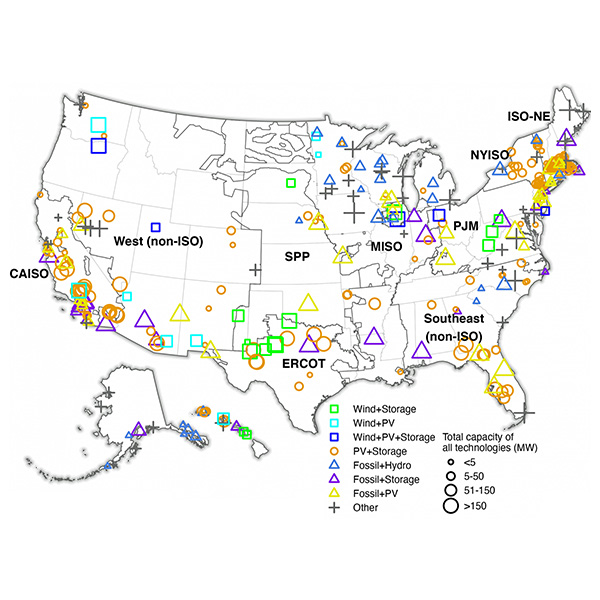
More hybrid power plants are being built in the U.S., the Lawrence Berkeley National Laboratory said Wednesday, and almost all of them combine photovoltaic generation with storage.
In the annual update of its data compilation, Berkeley said the number of hybrid facilities increased 25% in 2022. At the end of the year, it counted 374 hybrid plants with a nameplate capacity greater than 1 MW operating nationwide. Combined capacity was nearly 41 GW of generation and 5.4 GW/15.2 GWh of storage — increases of 15%, 69% and 88%, respectively, from a year earlier.
“Hybrid Power Plants — Status of Operating and Proposed Plants, 2023 Edition” is available on Berkeley’s website; the full presentation includes two case studies.
Also available is “Batteries Included,” a shorter summary of key takeaways from the 2023 report.
Among the findings:
-
- Solar-battery hybrids are the most common configuration, accounting for 213 of the total 374 plants and 59 of the 62 added in 2022.
- The other common configurations are fossil-solar (35), fossil-storage (26) and fossil-hydro (26).
- Hybrid configurations reflect their primary use cases — the relatively high average storage ratio and duration of solar-storage plants suggests the storage is providing resource capacity and energy arbitrage, while the low average storage ratio and duration of wind-storage plants suggest they are targeting ancillary services markets.
- Interconnection queue data show continued strong developer interest in hybridization: There were 51% more hybrid plants with 59% more generating capacity in queues nationwide at the end of 2022 than at the end of 2021. In one example, 97% of solar and 45% of wind in the CAISO queue were proposed as hybrids.
- The Inflation Reduction Act provided standalone storage with access to the investment tax credit for the first time, reducing some of the impetus for hybrid configuration, but that did not take effect until 2023, and Berkeley did not see any impact in the 2022 data.
- The capacity contribution of hybrids varies but is not equal to the sum of their parts; hybrids often share components such as inverters or interconnections, which can limit their output, as can operational constraints such as charging the storage only from the generator.
Berkeley concluded by saying “more research is needed to understand the full capability of hybrid projects. [Our] ongoing work focuses on themes of hybrid valuation, market rule development and customer resilience opportunities. The end goal of this research is to support private- and public-sector decision-making related to hybrid power deployment.”
